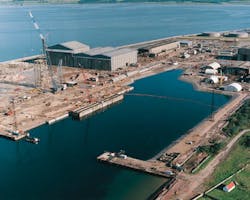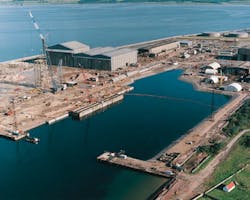Scottish yards shifting to global, floating markets
Barmac, Consafe, UIE upgrade facilities
Barmac's Nigg yard has the largest drydock, and one of the largest covered fabrication facilities in Europe.Scotland's yards reacted slower than their English counterparts to the shift in the North Sea away from conventional platforms. Now, though, they have re-equipped to handle most types of assignment, and also are more internationally minded than their competitors.
Most of the main Scottish facilities have work from the Norwegian and Danish sectors, while Barmac in Ardersier is delivering tubulars to Texaco in the Gulf of Mexico for the Petronius compliant tower. Consafe Group has cast its net even wider, opening a yard in Baku.
The biggest investment in Scotland was completed last August at the Nigg site of the Brown & Root/McDermott joint venture, Barmac. Here #7.5 million was spent building Europe's largest drydock on the Cromarty Firth. The dock was lengthened to 240 meters and steel reinforced to accommodate new types of floaters, TLPs, rig conversions, and decommissioned platforms.
Ironically, Nigg then ruled itself out of this type of work, in the short term at least, by clinching two major construction contracts:
- Elf's Elgin/Franklin production jackup
- The 100,000-ton South Arne gravity base structure for Amerada Hess in Denmark.
New floaters
Barmac also has plans to build new types of floaters designed by Brown & Root. One is a concrete FPU (in association with concrete specialists Taylor Woodrow/Costain), which would involve using the Nigg dock for hull slipforming and Ardersier for topsides fabrication.The targeted market is deepwater fields, particularly those off West Africa. Another, older Brown & Root concept still in the running is the square-hulled Barbox FPSO - this was proposed for Texaco UK's Mariner Field.
Elsewhere in the North Sea, Barmac is keeping a special watch on Statoil's Huldra Field project where a 6,800-ton substructure should come up for bid soon, and also two Shetland area developments, BP's Clair and Texaco's Torridon. To further its credentials, Barmac recently launched into a #2 million training program for its 2,000 employees, which also involves taking on 100 young apprentices.
Brown & Root was on the short list for the Brent Spar decommissioning. If appointed, the plan was to tow the spar in a horizontal position to Nigg, then dismantle it in the dock, recycling as much as possible. Even if it didn't win the work, Barmac, like numerous other yards, was waiting on the outcome of this long-running saga before committing itself to a new decommissioning facility on the west side of Nigg. Further attempts to stall the process by Greenpeace could set back plans for numerous other defunct North Sea facilities.
Assuming agreement can be reached on safe methods for larger installations, Nigg could offer heavier crane lifts - 1,300 tons individually - than other yards. It could also use McDermott's barges, which have a lift capacity of up to 4,000 tons. Across the waterway from Nigg, various companies from the Cromarty Industries Group are keen to get involved in any spin-offs. MacGregor Energy Services in Isleburn, for instance, could break up small steel substructures.
Consafe expanding
Probably the most versatile construction group in Scotland is Consafe Engineering UK, which has grown from turnover of #1 million since its formation in the mid-1980s to over #50 million currently.The company specializes in smaller topsides, accommodation modules, and subsea structures. It operates three small to medium-size yards along the Scottish east coast - overheads are less than at larger competing yards, so Consafe's profits tend to be a little higher for the type of work it undertakes.
Consafe employs close to 100 full-time design engineers and draughtsmen, covering all offshore disciplines except process. To date it has designed and fabricated just one of its numerous subsea manifolds, but it is keen to take on more all-round responsibility for such assignments, with so many subsea developments planned for the North Sea. The Montrose site manages most of the subsea work- structures up to 700 tons have been built there.
One of its higher profile jobs recently was the 1,000-ton turret manifold, including mainly duplex piping, for BP's Schiehallion FPSO. The turret, built to an SBM design, may be the largest of its type. This was assembled over nine months at Consafe Burntisland before delivery to main contractor Harland & Wolff last May. Consafe also built the Britannia Field subsea manifold, the UK's second largest to date, after Texaco's Strathspey.
Current work at the three yards includes the BP Bruce II compression platform topsides and bridge, living quarters for the Jotun and Bleo Holm floaters and the captain's bridge for the ?sgard A FPSO.
Consafe's most unusual assignment at present is the three-deck, 1,100-ton process topsides for BP Grangemouth's Hound Point terminal on Scotland's Forth river. This is for a project to recover marine vapors that escape during tanker loading and offloading - the biggest single loss of hydrocarbons from the Forties pipeline. The deck structure will be shipped out and lifted onto pre-installed piles at a location on the river adjacent to the tanker loading bays.
Now that Consafe has agreed to merge with Norwegian drilling contractors Procon and Safe Offshore, further expansion looks likely. Consafe has operated a welding training school and fabrication facility in Baku with a local Azeri company since 1995.
Recently, they moved to much larger premises in Baku - with blast and plaint shops on site - along with the engineering team working on the Shelf 5 drilling semisubmersible living quarters upgrade for the Shah Deniz project. Previously, the engineering had been handled by Consafe out of Aberdeen.
Last year Consafe set up a service office in Houston, which in the long term might be a springboard for fabrication of topsides modules in the US Gulf of Mexico and possibly other modules for the Mexican sector, the western and southern Atlantic.
UIE targest floaters
After delivering the wellhead platform for Texaco UK's Captain Field, UIE Scotland missed out on the next phase of North Sea platform jobs. With an army of FPSOs heading to refurbished docks in northern England, UIE responded by buying a disused shipyard at Inchgreen, a few miles west of its base on Glasgow's River Clyde. Here the water depth is 8 meters, but the main attraction was the existing 390-meters quay and the 305-meter by 44-meter drydock - one of the largest in the UK.Last month, the first offshore sector occupant arrived, Esso Norge's Balder Field FPU, which had been built in Singapore under sub-contract from Smedvig. The vessel then headed to Norway, but Esso was dissatisfied with aspects of Smedvig's work, so it transferred the vessel to Inchgreen for drydocking. The initial planned program was mainly riser extensions, but while in the dock, Esso identified other necessary changes.
Despite the large quay at Inchgreen, it would have been hard to accommodate two floaters there at once. When Bluewater's Bleo Holm FPSO went out to bid for topsides fabrication and fit-out, it dawned on UIE that the vessel's characteristics - no thrusters, for instance, - would allow it to come further up the Clyde to headquarters in Clydebank. To secure the contract, UIE agreed to extend the quay here by 100 meters, also dredging an area in front of the quay in order to install the riser system on the vessel.
Bleo Holm is a 100,000-ton newbuild, built by Hitachi in Japan, which will be leased to Talisman Energy (UK) for development of the Ross Field. Under a joint venture with Fluor Daniel, UIE is responsible for fabrication and onshore commissioning of over 6,000 tons of process topsides.
The working approach is new for UIE - it is building a series of small units which will then be installed on the vessel in a row, rather than a growing structure, as is the case with platforms. Because these are relatively simple steel units, there is greater requirement for mechanical pipework specialists rather than skilled welders.
UIE also will promote Inchgreen as a location for topsides construction for platforms and semisubmersibles, as well as FPSOs. It also interested in West Africa, particularly if parent company Bouygues Offshore secures another contract for a concrete barge.
Copyright 1997 Oil & Gas Journal. All Rights Reserved.

